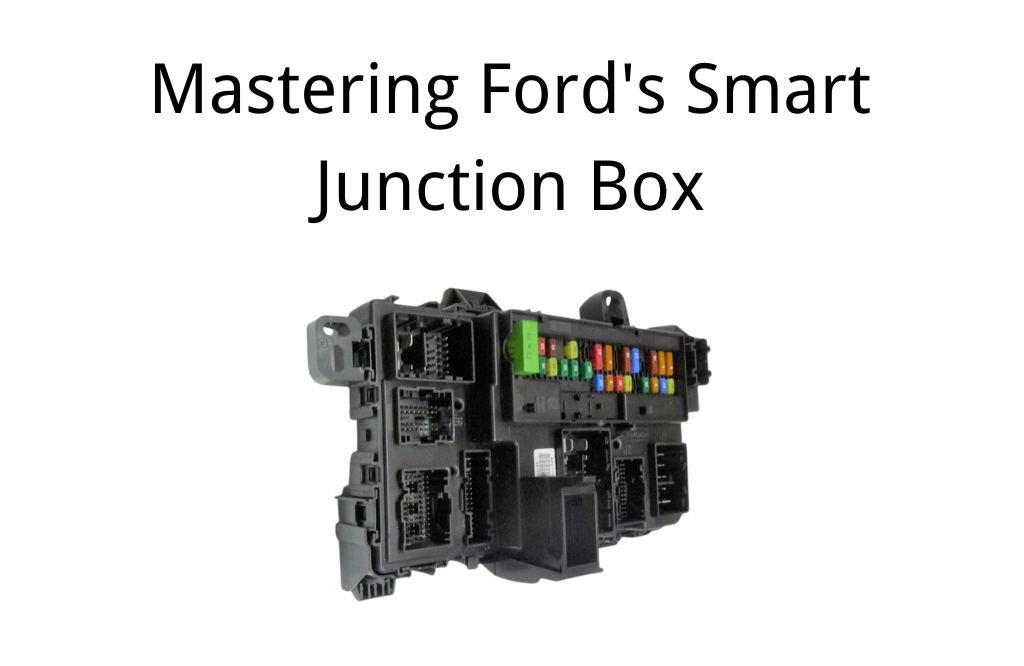A Ford Smart Junction Box (SJB) is more than just a fuse panel—it’s the central brain for many of your vehicle’s electrical functions.
Modern Fords rely on this advanced component to distribute power where it’s needed, protect circuits from overload, and facilitate communication among various electronic modules.
If you’re experiencing any odd electrical glitches—like flickering lights, malfunctioning door locks, or warning chimes that pop up without reason—the SJB is often a prime suspect.

Core Functions of the Ford Smart Junction Box
Power Distribution
The SJB takes incoming power from the battery and channels it to essential electrical systems and subsystems. Rather than simply routing current, it can regulate voltage and supply the appropriate amount of electricity based on each system’s requirements.
Fuse and Circuit Protection
Like a traditional fuse box, the SJB contains fuses and sometimes relays to guard against short circuits or overloads. When a fault occurs, it can detect the issue and potentially shut down the affected circuit, helping to prevent bigger, more expensive problems.
Network Communication
Acting as a communication gateway, the SJB enables data exchange between modules (for example, your engine control unit, transmission module, and body control systems). This interconnected approach is why newer Fords can pinpoint and log diagnostic trouble codes with greater accuracy.
Control and Integration
Whether it’s turning on the headlights, rolling up the power windows, or locking the doors, the SJB is responsible for “listening” to inputs from sensors, switches, and other signals, then issuing the correct commands to the corresponding components. Essentially, it coordinates these electronic processes for a smoother driving experience.
Fault Monitoring and Diagnostics
Smart Junction Boxes continuously scan for irregularities—like open circuits or communication errors—and often store diagnostic trouble codes (DTCs). If something goes wrong, you might see a warning light on your dashboard or discover saved codes when you connect a diagnostic tool.
Energy Efficiency
By activating and deactivating specific components as needed, the SJB helps conserve electrical power. This kind of intelligent load management can contribute to better fuel efficiency and overall vehicle performance.
Why You Should Care About the SJB
If your SJB stops doing its job effectively, you’ll know it. Common pain points include:
- Erratic interior or exterior lighting
- Non-responsive door locks or power windows
- Intermittent warning chimes and dashboard alerts
- Starting issues that don’t stem from the battery or starter
These frustrations can worsen if you’re unsure whether the root cause is in the SJB, the wiring, or another module. Since the SJB is integral to so many systems, it’s often a good place to start when troubleshooting electrical gremlins.
Typical Location and Variations
Depending on your Ford’s model and year, the Smart Junction Box could be under the dashboard, in the passenger compartment, near the engine bay, or even in the trunk area.
Check your owner’s manual or an official service manual for exact positioning. Some SJBs look quite different depending on technological advancements and vehicle architecture, so don’t be surprised if you see variations in shape, connector placement, or mounting points.
Common Problems and Symptoms of Failure
Corrosion or Moisture Intrusion
Because the SJB has multiple connectors and circuits, any moisture can quickly lead to corrosion. Symptoms often include flickering lights, odd noises, or random electronic hiccups.
Short Circuits and Fuse Issues
A single blown fuse can knock out an entire feature (like the radio or interior lighting). In some cases, a more severe short circuit can cause multiple subsystems to fail.
Communication Errors
When internal components can’t relay data properly, you might see erroneous dashboard warnings or have modules that refuse to coordinate with each other.
How to Replace or Repair the SJB
If you’ve identified the SJB as the culprit, you might consider a replacement or professional repair.
Here’s a brief overview:
Disconnect the Battery
Always start by removing the negative battery cable to avoid shock or damage to sensitive electronics.
Locate and Remove
Find the SJB and carefully unbolt/unclip it from its mounting bracket. Label or photograph all connectors so you know where they go when you’re done.
Swap and Secure
Attach the new (or rebuilt) SJB in place and reconnect all wiring harnesses. Double-check each connector before securing them.
Reprogramming or Reset
Modern SJBs sometimes need to be programmed to match your specific vehicle settings. This step often requires specialized diagnostic tools, so consult a trusted mechanic if you’re not equipped.
Cost Considerations
A brand-new original Ford Smart Junction Box can be pricey. Some owners look for refurbished or secondhand units to keep costs down, but be aware of potential compatibility or warranty issues.
Labor charges may also add up, especially if reprogramming is required.
Upgrades, Retrofits, and Efficiency
In some cases, upgrading your SJB (or performing a retrofit from an older box to a newer variant) can unlock additional features like more advanced lighting controls or better diagnostic capabilities.
However, always confirm compatibility—installing an incompatible junction box can create more electrical headaches than it solves.
Many SJBs also incorporate features aimed at energy efficiency. By selectively powering down certain systems when they’re not in use, your vehicle conserves resources and can operate more efficiently overall.
Final Thoughts
Understanding the Ford Smart Junction Box goes a long way toward resolving pesky electrical issues and ensuring all your vehicle’s functions run smoothly. From providing power distribution to enabling advanced diagnostic communication, the SJB truly is the “nerve center” of your Ford.
If you’re dealing with inconsistent electrical performance, weird dashboard warnings, or unexplained fuses blowing, consider taking a closer look at this vital component.
Bottom line: While the SJB offers enhanced safety and convenience through intelligent management of your car’s electrical systems, it can be complex to troubleshoot or replace. If you suspect yours is acting up, start with a basic inspection, consult your service manual, and don’t hesitate to seek professional assistance if reprogramming or detailed diagnostics are required.
It’s a small box with a big job—and ensuring it’s in top shape can save you endless frustration on the road.




Leave a comment
This site is protected by hCaptcha and the hCaptcha Privacy Policy and Terms of Service apply.